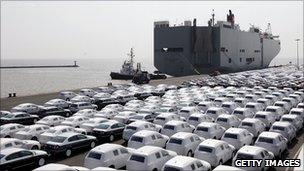German economy sees 'record' growth of 2.2%
- Published

Strong exports helped to boost German growth
The German economy grew by 2.2% in the three months to the end of June, its fastest quarterly growth in more than 20 years, official figures show.
"Such quarter-on-quarter growth has never been recorded before in reunified Germany," the national statistics office, Destatis, said.
The main reason for the higher-than-expected growth was strong exports, helped by a weaker euro.
The eurozone economy grew by 1% during the quarter.
This compares with growth of 0.2% in the first three months of the year, the area's official statistics agency, Eurostat, said.
The French economy grew by 0.6% in the second quarter, also up from 0.2%, while the Spanish economy grew by 0.2%, compared with 0.1% in the previous three months.
The pace of growth in the Italian economy remained the same, at 0.4%.
Greece, however, saw its economy shrink by 1.5% during the quarter. The country's government has instigated a series of far-reaching austerity measures recently, designed to reduce its high budget deficit.
All the second quarter figures are initial estimates and could be revised up or down in the coming months.
The eurozone quarterly GDP figures show that the economic recovery in Europe gained pace between April and June. The UK has also reported higher-than-expected growth of 1.1% for the period.
In the US, however, second quarter growth was 0.6%, down from 0.9% between January and March, raising questions about the strength of the recovery in the world's biggest economy.
"Second quarter GDP data for the eurozone's major economies suggest that the region performed very well, both by its own and international standards," said Jennifer McKeown at Capital Economics.
"This would be the strongest in three-and-a-half years and mean that, unusually, growth in the eurozone outpaced that in the US."
However, along with other analysts, she highlighted concerns about the strength of the recovery in "peripheral economies", such as Greece and Spain.
(Article continues below)

'Rapid recovery'
Destatis also revised up the German growth figure for the first three months of the year, to 0.5% from 0.2%.
As well as the "strong contribution" from exports, the office said household and government spending also helped to boost growth in the second quarter.
"The German economy is recovering rapidly," it said.
Analysts had expected second quarter growth of about 1% to 1.5%.
"The strong second quarter performance of the German economy is impressive but not surprising," said Carsten Brzeski at ING Financial Markets.
"The German economy mainly benefited from two factors - a catching up in the construction sector after the harsh winter and strong foreign demand for German goods."
Despite the strong figures, economists do not expect the German economy to continue growing at such a fast pace.
"Looking ahead, it is almost needless to say that the current growth momentum is hardly sustainable in the coming months. With the one-off impact from the construction sector and normalising of export growth, German growth will return to more ordinary numbers," Mr Brzeski said.
The German Economy Minister, Rainer Bruederle, said the latest quarterly GDP figures "make growth of well above 2% possible for 2010".
Wider impact
Germany is Europe's largest economy and the world's second largest exporter behind China.
The fact that its exports are growing strongly is a good sign for the global economy, analysts said.
German manufacturers use many components from eurozone economies, helping them to grow, while strong demand for German products overseas is a sign that global economies are recovering.
Norbert Walter, former chief economist at Deutsche Bank, told BBC Radio 4's Today programme: "The Dutch economy, the Belgian economy and the Austrian economy will flourish in a month's time if the German economy is doing well because, [for example], no German car leaves the country without an axle that comes from Belgium.
"There is an intra-industry trade that propels the economies of the neighbouring countries".
Equally, he said, exports of capital goods such as industrial machinery to south east Asia and Latin America helped them to modernise their economies.